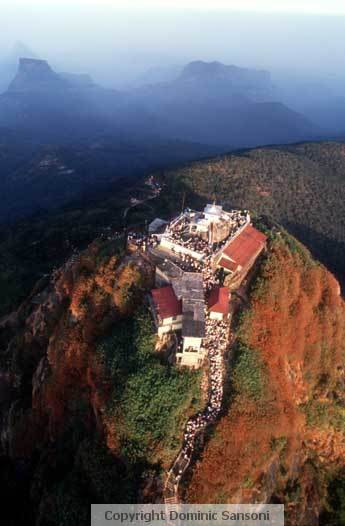Sri Pada: An Historical Account

|
Much has been written and spoken about this mountain since immemorial times by the inhabitants of the island and foreigners, as well. This is the second highest mountain in the island, 7341 feet above the sea-level, while Pidurutalagala, the highest mountain rises 8,282 feet. People from all walks of life climb this mountain starting from December every year. It is a spectacular event in every sense of the word.
In his celebrated book The God of Adam's Peak (1957), Professor Senerath Paranavithana, the renowned archaeologist, historian, writer and erudite scholar par excellence, writes the following.
"Among the numerous mountain peaks which rise from the central massif of the Island of Ceylon, the most famous though not the highest, is Adam's Peak known among the Sinhalese as Siripada (the Illustrious footprint) or Samanala Kanda (the Peak of the God Saman). The upper part of the mountain rising like a pinnacle from the surrounding peaks, is seen from many points in the plains and from the sea.
The steep sides from the mountain are difficult to climb, but when one arrives at the summit, with the help of chains and steps cut on the rocks, one is confronted with a scene of undescribable grandeur, particularly if the climb is accomplished so as to be at the summit at sunrise. Geographically Adam's Peak is important as the main watershed of Ceylon, four of the principal rivers of the Island, including the Mahaveli Ganga, the longest, having their source from this mountain, and falling to the sea on the eastern, western and south eastern coasts. The districts to the south and the east of Adam's Peak yield precious stones-emeralds, rubies, sapphires, etc, for which the Island has been famous, and which have earned for its ancient name of Ratnadvipa".
God Saman is one of the four deities, who undertook to protect the island and Buddhism in Lanka according to Mahavamsa, the early chronicle in Sri Lanka.
Much veneration has been extended to this mountain and it is mainly due to the belief and the identification of the Footprint at the summit by the Sinhala-Buddhists as the Footprint of the Gauthama Buddha, who had visited this island three times. Muslims believe it to be the Footprint of Adam, while Hindus believe it to be that of God Siva.
During the Buddha's first visit to Mahiyangana he preached his doctrine to celestial beings. One of the prominent figures at the assembly was God Maha Sumana of the Samantha Kuta. God Maha Sumana attained the first fruit of the path of 'Nirvana' (Sotapatti Phala) and requested the master for an object for worship. The Buddha gave Him a lock of hair from his head and it was enshrined in the Mahiyangana Thupa, the first Dagoba constructed in the Island during the lifetime of Buddha at the initiative of God Maha Sumana.
When the Buddha visited the island for the last time of Kelaniya, at the request of God Maha Sumana, the Buddha left the trace of His footprint on the mountain according to Mahavamsa. However, Professor Paranavitana notes that earlier chronicles, such as, Deepavamsa or the Buddhaghosa's Samanthapasadika have no reference to Samanthakuta or the God Maha Sumana. God Maha Sumana has never been identified as a Hindu God. There are two important and significant Devales constructed at Ratnapura and Mahiyangana dedicated to this God.
The first historical mention about Siri Pada comes during the reign of Vijayabahu. Professor Paranavitana states: "It is in the reign of Vijayabahu (1055-1110) we have the earliest historical evidence in chronicles and inscriptions by the cult of the Footprint on Adam's Peak. It is recorded of this monarch that he, having seen the difficulties undergone by the pilgrims on their way to worship the Buddha's footprint on Samanthakuta dedicated the village named 'Gilimale' to provide for their needs. Stone inscriptions of Vijayabahu have been found at Gilimale and Ambagamuwa confirming the statement of the chronicle".
King Nissankamalla (Dravidian King during the Polonnaruwa period famous for his self-commendations) who ascended the Sinhalese throne in 1187 A. D. is stated to have visited the Samanthakuta with his four-fold army and worshipped the Footprint with great devotion. He had re-granted the Village Ambagamuwa and it has been recorded in an inscription found in a cave known as Bhagavalena. He had constructed a concrete slab to protect the Footprint.
A Pali poem "Samantha Kuta Vannana" by a monk named Vedeha in the 13th century confirms the increasing interest shown by the Sinhala-Buddhists to the cult of this Footprint. In our recorded history, a good number of ancient kings have visited the mountain from time to time. Parakramabahu (II) (1225-1269) visited the Footprint and paid homage. His minister, Devaprathiraja constructed roads leading to the mountain and installed iron chains on iron posts to make the ascent easy and conducted great festivities in celebrating to worship of the Footprint. Parakramabahu's son, Vijayabahu, and other kings like Vikramabahu, Vimala Dharmasuriya (1687-1707), his son Narendrasinghe (1707-1730) were among Sinhala Kings who had visited the Footprint to pay homage.
King Vimala Dharmasuriya constructed a silver umbrella over the Footprint. Rajasinghe I (1581-1593) who became a Hindu convert had also visited the Footprint. Śrī Vijaya Rajasinghe (Nayakkar King) who became the Kandyan king in 1739, had also visited the mountain. Kirthi Śrī Rajasinghe, (1747-1789) during whose reign, Buddhist renaissance took place had visited the Footprint and restored to the Buddhists' incomes withdrawn by Rajasinghe I. He also donated the village, Kuttapitiya and the copper plate charter in support of this donation is still in existence.
Manimekalei, Tamil Poem attributed to have been written in the 6th century outside the island, refers to the Footprint of the Buddha on the high peak of Samanthakuta and narrates the story of spiritual beings worshipping (Samanoli) which is equivalent to 'Samanola' in Sinhala language.
by P. G. G. Palihapitiya
courtesy: The Daily News (Colombo) of Saturday, 13 December 2003